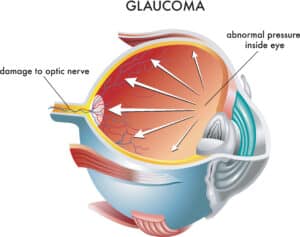Do you want to reduce your risk of developing glaucoma? Keep reading to learn about the most common risk factors and prevention tips for this common eye disease.
What Is Glaucoma?
Glaucoma is an eye condition that occurs when pressure builds up in the eye and damages the optic nerve. The pressure build-up is a result of poor fluid drainage from the eye. Glaucoma is currently the second leading cause of blindness in the world today, so it’s an extremely common—yet treatable—condition.
Two types of glaucoma:
- Open-Angle Glaucoma: This is the most common type of glaucoma. The structures of the eye appear normal, but fluid in the eye does not flow properly through the eye drain—which is called the trabecular meshwork.
- Angle-Closure Glaucoma: This type of glaucoma is less common than open-angle but can cause a sudden pressure buildup in the eye. Drainage may be poor because the angle between the iris and the cornea—where a drainage channel for the eye is located—is too narrow. Another potential cause is that the pupil opens too wide, narrowing the angle and blocking the flow of fluid through that channel.
Common Glaucoma Symptoms
Take a look at the most common symptoms associated with each type of glaucoma in their different stages.
Open-Angle Glaucoma
- Early stages: loss of peripheral vision
- Later stages: loss of central vision
Acute Angle-Closure Glaucoma
- Headaches
- Eye pain
- Nausea or vomiting
- Blurry vision
- Halos around lights
- Eye redness
Normal-Tension Glaucoma
- Early stages: no symptoms
- Middle stages: blurry vision
- Later stages: loss of peripheral vision
Glaucoma in Children
- A dull or cloudy eye
- Increased blinking
- No tear production when crying
- Blurred vision
- Deteriorating nearsightedness
- Headache
Pigmentary Glaucoma
- Halos around lights
- Blurry vision during exercise
- Gradual loss of side vision
Glaucoma Risk Factors
People who fall into one or more of the following categories may need to schedule more frequent eye exams.
- Family history of glaucoma
- Diabetes
- Of African descent and over age 40
- Over age 60
Ages to Look Out For
Here are our general guidelines for how often people in certain age groups should schedule a comprehensive eye exam. While glaucoma is most common in adults over age 40, it can occur in people of all ages.
- Under 40: every two to four years
- 40-54: every one to three years
- 55-64: eye exam every one to two years
- 65+: every six to 12 months
Glaucoma Prevention
While there is no known way to prevent glaucoma, some simple lifestyle changes can reduce your chances of developing glaucoma and slow its progression in those who already have it.
1. Schedule Routine Eye Exams
Routine eye exams are the #1 way to lower your risk of glaucoma. Since glaucoma symptoms typically don’t appear until the later stages, comprehensive eye exams with dilation allow for early detection and treatment. They’re especially important for those with a family history of glaucoma.
Routine eye exams also ensure general eye health and help your physician check for any underlying health conditions you may not be aware of.
Find a Cleveland Eye Clinic location near you!
2. Exercise Regularly
Exercising regularly can reduce your likelihood of developing glaucoma. Whether you choose to go on long walks, do yoga, or take the stairs instead of the elevator at work, low-impact exercises in moderation can help lower the high intraocular pressure associated with glaucoma. Be careful not to overdo it; too much exercise can do more harm than good.
3. Maintain a Healthy Diet
Antioxidant-rich foods like leafy greens, fish, nuts, and berries can help you maintain healthy blood sugar, blood pressure, and cholesterol levels. The lower these numbers are, the lower your intraocular pressure will be. 
4. Protect Your Eyes
Protecting your eyes is essential to avoiding glaucoma. Anytime you’re outside or driving your car in during daylight hours, you should wear sunglasses with adequate UV protection. It wouldn’t hurt to also wear a hat. Even when wearing sunglasses, never look directly at the sun. You should also wear protective eyewear when playing contact sports, mowing the lawn, and completing home renovation projects.
5. Take Medication
If the above methods don’t reduce your intraocular pressure enough, your doctor may prescribe medication. Glaucoma medication can help prevent long-term damage to the optic nerve.
Surgical Glaucoma Treatment
iStent® Trabecular Micro-Bypass—better known as iStent—is a technology used during glaucoma surgery. The glaucoma iStent is a small tube-like device that a physician places in the eye’s blocked drainage canal to allow fluid to pass through, thus lowering intraocular pressure. Glaucoma stents like the iStent device help reduce one’s risk of developing glaucoma and slow the progression of the disease.
While effective, the glaucoma iStent is not a fix-all for glaucoma. Patients who undergo this eye stent procedure for glaucoma may still rely on medication and other treatments to lower intraocular pressure.
Contact a Cleveland Eye Clinic Physician for Clear Vision
Whether you want to schedule an annual eye exam or ask about the glaucoma iStent procedure, the leading physicians at Cleveland Eye Clinic are here to help. Schedule an appointment today to protect your eye health.








